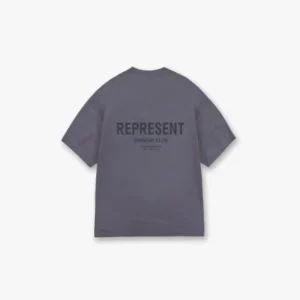The T-shirt is more than just a piece of clothing Represent T Shirt it is a universal symbol of casual style, comfort, and self-expression Represent From its humble beginnings as an undergarment to its current status as a versatile wardrobe essential, the T-shirt has undergone a significant transformation over the years. Its evolution reflects broader cultural shifts and changing fashion trends, making it a fascinating garment to explore.
The Origins of the T-Shirt
The T-shirt’s journey began in the late 19th century as an undergarment worn by sailors and soldiers. Originally designed for its practicality and comfort, the T-shirt was made from lightweight cotton, which made it breathable and ideal for layering. By the early 20th century, the T-shirt had become standard-issue military wear, providing soldiers with a simple Represent Clothing functional garment that could withstand the rigors of battle.
After World War II, returning soldiers brought the T-shirt into mainstream fashion. The garment quickly gained popularity among the general public, especially in the United States, where it became a symbol of youthful rebellion. Iconic figures like Marlon Brando and James Dean popularized the T-shirt in movies like “A Streetcar Named Desire” and RepresentHoodie Rebel Without a Cause,” solidifying its place in popular culture.
The T-Shirt as a Canvas for Self-Expression
As the T-shirt gained popularity, it evolved beyond its utilitarian roots to become a powerful medium for self-expression. In the 1960s and 1970s, the rise of screen printing technology allowed designers to create T-shirts with bold graphics, slogans, and artwork Represent Sweatshirt This development transformed the T-shirt into a blank canvas for political statements, band merchandise, and promotional material.
The graphic T-shirt became a symbol of the counterculture movement, with activists using it to promote social and political causes. Band T-shirts, featuring the logos and artwork of popular music groups, became a way for fans to show their allegiance and support. In the corporate world, companies began using T-shirts as promotional tools, recognizing their potential to reach a wide audience.
Today, the T-shirt remains a popular medium for self-expression. From fashion brands collaborating with artists to create limited-edition designs Represent sweatpant to individuals customizing their own shirts with personal messages, the T-shirt continues to be a versatile platform for creativity and individuality.
The Evolution of T-Shirt Styles
Over the years, the T-shirt has evolved to encompass a wide range of styles, fits, and fabrics. The classic crew neck and V-neck styles remain popular, but designers have introduced new variations to cater to different tastes and preferences Represent Shorts Oversized T-shirts, cropped T-shirts, and fitted T-shirts offer options for every body type and fashion sensibility.
The choice of fabric has also expanded, with T-shirts now available in a variety of materials, including organic cotton, bamboo, and recycled fibers. These sustainable options reflect the growing demand for eco-friendly fashion and the desire to reduce the environmental impact of clothing production.
Color and pattern have played a significant role in the evolution of T-shirt styles. While white T-shirts remain a timeless classic, vibrant colors, tie-dye patterns Represent HAT and graphic prints have become increasingly popular. These variations allow individuals to express their personality and mood through their choice of T-shirt.
The T-Shirt in High Fashion
The T-shirt’s versatility and universal appeal have not gone unnoticed by the high fashion world. Luxury brands have embraced the T-shirt, incorporating it into their collections and elevating it to a status symbol. Designer T-shirts, often featuring bold logos or unique designs, have become coveted items, blurring the line between casual wear and luxury fashion.
Collaborations between high-end designers and streetwear brands have further cemented the T-shirt’s place in contemporary fashion. These partnerships have produced limited-edition pieces that combine the craftsmanship of luxury fashion with the accessibility of streetwear, making the T-shirt a key element in the modern wardrobe.
The Future of the T-Shirt
As fashion continues to evolve, the T-shirt is likely to remain a staple for years to come. Its enduring appeal lies in its simplicity, versatility, and ability to adapt to changing trends. Whether worn as a statement piece, a layering essential, or a comfortable everyday garment, the T-shirt has proven to be a timeless addition to any wardrobe.
In the future, we can expect to see continued innovation in T-shirt design and production, with a focus on sustainability and technology. As consumers become more conscious of their environmental impact, the demand for eco-friendly materials and ethical manufacturing practices will drive the development of new T-shirt styles. Additionally, advancements in textile technology may lead to the creation of smart T-shirts with integrated features, such as moisture-wicking properties or temperature regulation.
In conclusion, the T-shirt is more than just a basic piece of clothing. It is a cultural icon, a fashion staple, and a canvas for creativity and self-expression. From its origins as a practical undergarment to its current status as a versatile wardrobe essential, the T-shirt has come a long way. As it continues to evolve, the T-shirt will undoubtedly remain a beloved garment that transcends generations and styles.
